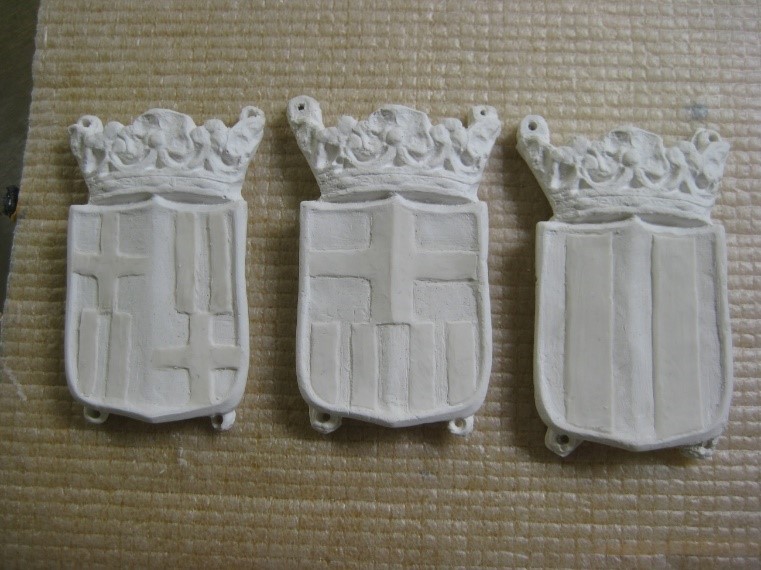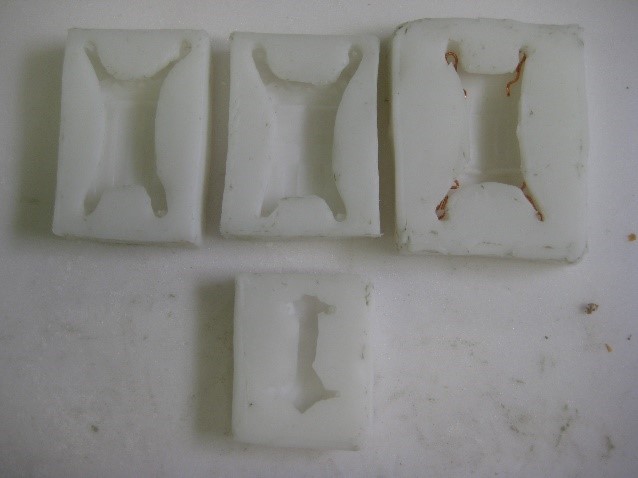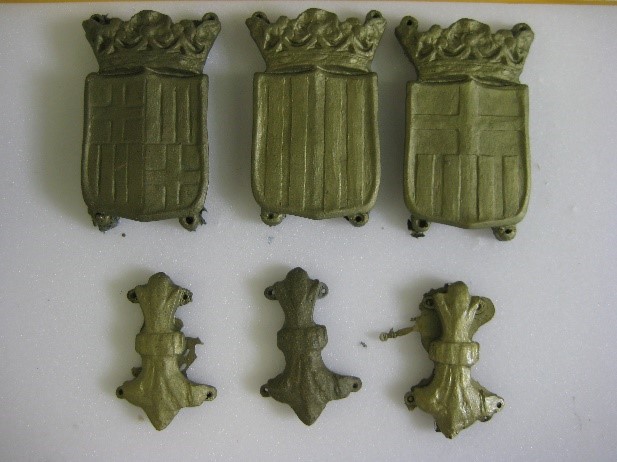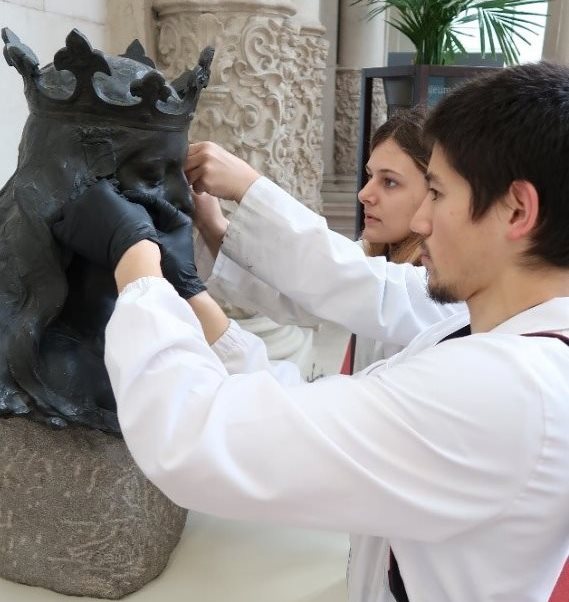Àlex Masalles
Among the white marble sculptures in the Dome Hall of the Museu Nacional, there is, to the left of the door to the restaurant, a work in bronze with a dark patina mounted on a base of Montjuïc stone. It is an allegorical representation of the city of Barcelona by the sculptor Eusebi Arnau.

Eusebi Arnau, Bust of a Noblewoman Representing Barcelona, 1897. Bronze and Montjuïc stone
The 1897 original
The original plaster model of this bust, signed and dated in 1897, was part of the project presented by the architect Josep Puig i Cadafalch in the competition held in 1896 by Barcelona City Council to erect a monument to Francesc de Paula Rius i Taulet, a former mayor of the city.
This project won second prize and the council purchased the work for 500 pesetas, to put it in the Museu de Belles Arts. The plaster bust accompanied the model that appeared with number 5 and the motto “Mirau-la; os de mos ossos, s’és feta gran com jo!” (Behold; bone of my bones, it has grown as large as me!) (a verse from Oda a Barcelona (Ode to Barcelona) by Jacint Verdaguer, last verse, second stanza).
The present one cast in bronze was made in 1906 at the Masriera i Campins S.A. Artistic Foundry in Barcelona. The founder’s mark is clearly visible on the figure’s left shoulder.
Arnau repeated the iconography on the obverse of a medal made in 1907 for the 5th Barcelona International Art Exhibition, on which he incorporated the bust of the representation of the city of Barcelona, now in profile, with a crown, chinstrap and laurel leaves.

Eusebi Arnau, Obverse and reverse of the bronze medal of the 5th Barcelona International Art Exhibition, 1907
What old photographs show us
Thanks to an old black-and-white photograph of the bronze cast conserved in the museum’s Modern Art department we know that the figure originally wore a crown incorporating an articulated chinstrap (in the manner of a chain fastening the crown under the chin), with different coats of arms related to the city of Barcelona. These elements framed the noblewoman’s face and gave it the aura of solemnity required by the allegorical representation of the city.
For many years the chinstrap was missing from the sculpture, and it presented an image quite different to its original iconography.
Luckily, two pieces had been conserved in the museum Register that belonged to the articulated chinstrap of the bronze in the museum: a coat of arms with the cross of Saint George and a hinge in the form of a fleur de lis. Once the criteria had been agreed upon with the conservators, these made it possible to tackle the reincorporation of the missing parts, taking advantage of the stay by the interns from the Faculty of Fine Arts, Andrea Barbarà and Mario Vazza.
There was very little existing photographic documentation: the cardboard box in which the pieces of the original chinstrap were kept has a small, virtually unknown black-and-white photograph of the original plaster model stuck on its lid.
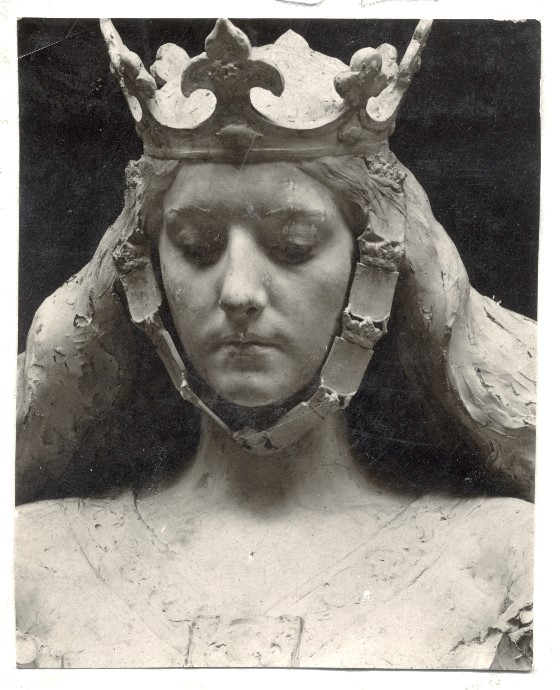
Detail of the 1897 plaster model. Digitization of the photograph stuck on the lid of the box that contained two original pieces of the chain
Studying them has shown us two important aspects of the sculpture:
- There are striking formal differences between the chinstrap of the original plaster model and that of the bronze. While a total of eight coats of arms centred at the bottom by a fleur de lis can be seen on the plaster model, the bronze in the photo only has six coats of arms with a total of five fleurs de lis acting as links between each pair of shields. Most likely these modifications were the result, not of a change of heart by the artist, but of the technical solution adopted to translate the compact shapes of the plaster model into the language of metal, creating a chinstrap of articulated elements.
- The black-and-white photo of the bronze, whose date is unknown, clearly shows that the heraldic themes on the four coats of arms are different, while the shields on the plaster model have a blank field. To the cross of Saint George on the original metal coat of arms conserved, we must add the four bars, a truncated shield with the cross and four bars, and the quartered coat of arms of crosses and bars of the city of Barcelona.
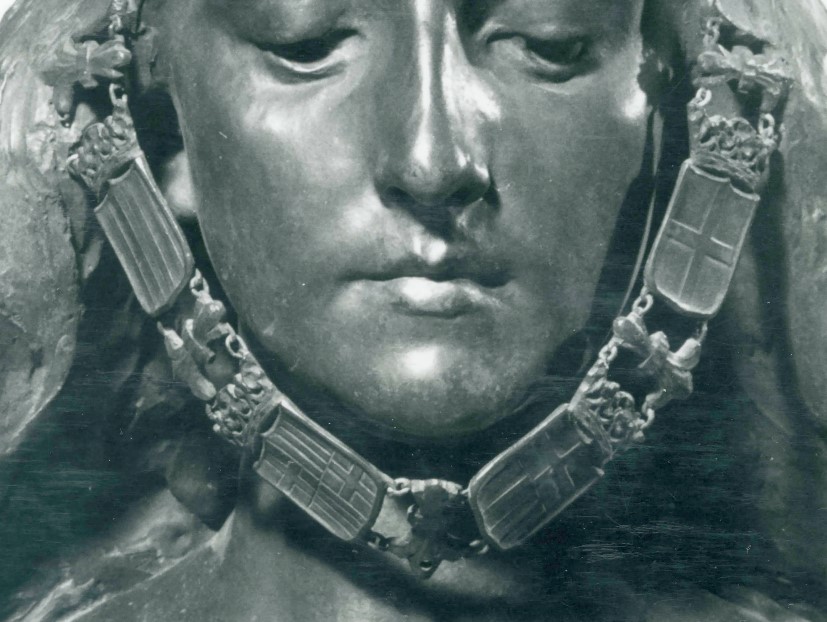
Detail of the original chinstrap in which we can see in detail the theme of each coat of arms and the articulation of the pieces with rings
Taking into account these variations, both with respect to the original plaster model and between the coats of arms, as a criterion for the repair work we thought it would be appropriate to carry out a mimetic repair, with regard to shape and colour, based on the original pieces and the information contained in the photographs, but in a synthetic material totally different to the original metal. In this way the new parts are fully integrated with the original, recovering the interpretation of the bust as a whole and at the same time ensuring the reversibility and traceability of the work.
The work, step by step
- The first step was to make silicone moulds of each of the original bronze pieces, after applying a protective coat.
- The moulds were used to obtain different plaster reproductions from which, after removing the cross to leave the field blank, the three lost coats of arms were obtained by modelling the new themes in white Plasticine.
- Then the silicone models of the three new coats of arms were made, and the corresponding positives were obtained in epoxy resin with metal powder, inserting copper rings in the mixture to reinforce the links.
- With the original fleur de lis mould, three new flowers were made that act as links between the coats of arms.
- Once the rough edges were removed and the holes retouched, the fixing rings were made with brass wire.
- It was necessary to perform several tests to adjust the separation between the coats of arms in order for the chinstrap to fall as symmetrically as possible with respect to the axis of the face, and to ensure that the fleur de lis in the centre is aligned with the hole on the front of the figure’s throat.
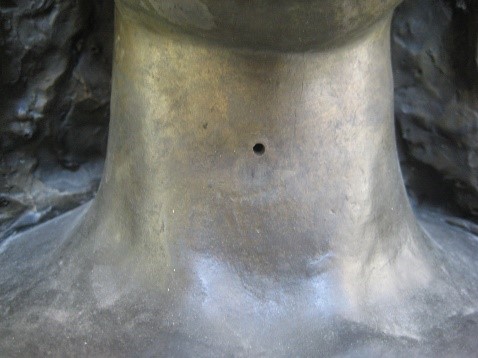
Detail of the hole on the front of the figure’s throat that was used to fasten the chinstrap
- On the new resin pieces and the rings, an artificial patina of coloured varnish was applied on a gilt ground with metal powder in order to match them with the colour of the original bronze patina.
- The final mounting of the chinstrap was completed with the incorporation of a metal bolt to fasten them through the hole in the figure’s throat.
Installation of the recovered work
To finish off, and once the original look of Arnau’s work had been recovered, the only thing left to do was to suggest exhibiting the bust at a higher level, which would produce a lower point of view and, in our opinion, would enhance the vigorous nature of the representation.
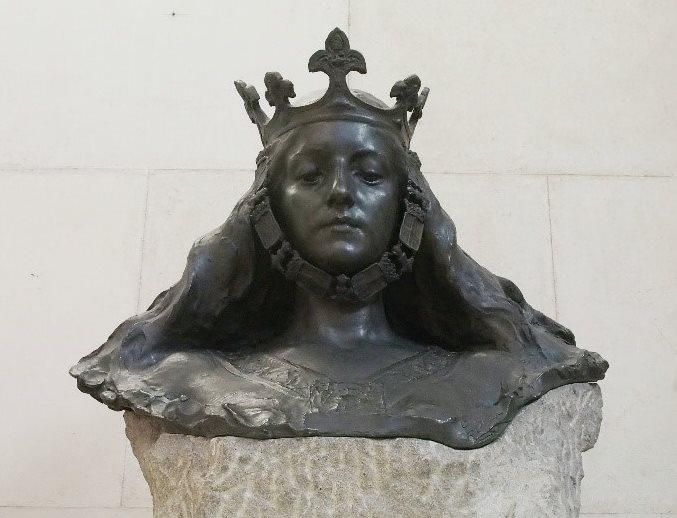
The sculpture once the work was finished, photographed from a lower point of view that reinforces the power of the allegorical figure
Related links
Other works by Eusebi Arnau in the Museu Nacional’s collection
Conservador-restaurador de materials inorgànics




